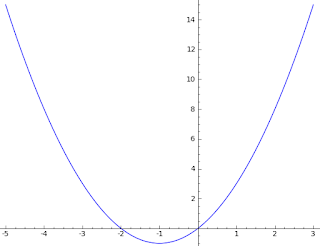The instantaneous rate of change concept has an inherent difficulty.
It takes the idea of the average rate of change, the slope a secant line between
two points and attempts to identify a tangent line hitting the curve at a single point.
Limits and the Instantaneous Rate of Change
A single point does not define a line but we don't let that bother us since we are guided to this tangent line by the secant lines. Geometrically and algebraically we can often visualize this tangent line as the end result of a sequence of secant lines.
But to be precise and careful about the IRC, we need to first develop the idea of a
limit.
The concept of
limit (limit of a sequence, limit of a function, limit of a sequence of functions) is a fundamental idea in calculus and modern mathematics.
We digress from our study of the IRC to develop a theory of limits.
Limits -- a digression
We will look at limits in three ways,
- geometrically, visually, using a graph.
- algebraically, using algebra manipulations and substitution.
- via tables, plotting values as the x-coordinate (input) changes.
This material is described in sections 2.1 and 2.2 in the textbook by Rogawski.
Consider a point
P(x,f(x)) and a nearby point
Q(x+h, f(x+h)). If we really want to know how the function
f(x) changes at (x,f(x)) we might compute the ARC as the second point
Q approaches the first, that is, as the distance between the two points shrinks to zero.
This is the Instantaneous Rate of Change (IRC). It is the limit, as
h -> 0, of the ARC.
The IRC is also a
slope. It is the slope of the ``tangent" line at the point
P.
We will look at the IRC in three ways
- geometrically, as the slope of the curve (or ``tangent line")
- algebraically, using limits
- via a table, computing the ARC as $h$ shrinks to zero.
Before we continue with the IRC, however, we need to explore the concept of limits.
Limits using a calculator
We may use our calculator to compute a limit.
Sample problems
Let's use our calculator to compute the limit of the function f(x) = (3x)/(x^2+4) as
x approaches 2. To do this, we might plug in some numbers slightly greater than 2 such as
x = 2.1 or
x = 2.01 or
x = 2.001.
We might guess from this work that as
x approaches 2 from above (from values slightly higher than 2) then the function
f(x) approaches 0.75.
We write this
lim x -> 2^+ (3x)/(x^2+4) = 0.75
(The plus sign above the 2 in the limit notation means that we are approaching 2 from above.)
We could approach 2 using numbers slightly lower than 2.
We might try
x = 1.9 or
x = 1.99 or even
x = 1.999.
Once again, the values of the function seem to approach 0.75 so we write
lim x -> 2^- (3x)/(x^2+4) = 0.75
(Here the negative sign above the 2 in the limit notation means that we are trying numbers slightly less than 2.)
Since we are approaching f(x) = 0.75 no matter how we approach
x = 2, we summarize this by saying that the limit of
f(x) as
x approaches 2 is 0.75.
We write this as
lim x -> 2 (3x)/(x^2+4) = 0.75
without any sign of direction over the 2.
One might notice that in this case, the value of 0.75 is not surprising.
After all, if one plugs in
x = 2 to the function, we find that f(2) = 6/8 = 3/5 = 0.75.
In this case, we could have probably skipped computing values of
f(x) near x = 2 and gone right to
f(2). (We will say more about this later.)
Let's try another problem and, using a calculutor, estimate
lim t -> 1^- (t^2+2t-3)/(t^2-1).
We could create a table of values with
t = 0.9,
t = 0.99,
t = 0.99. Notice that we are approaching
t=1 from below. From this we might guess that
lim t -> 1^- (t^2+2t-3)/(t^2-1) = 2.
Notice this time that it does no good to try and skip pass our limit computation and just plug in
t=1.
The function
f(t) is
not defined at
t = 1 and so this direct attempt would fail.
The geometric interpretation of limits
One should develop a geometric interpretation of limits.
Consider the following picture from the
OpenStax calculus book.
Here the secant lines (like the one in orange) converge to the tangent line. We will return to this idea after we finish the basic properties of limits.
Resources
Here is an online animation of the limit concept.
Homework
Do Worksheet 1.3 on Introduction to Limits.


























